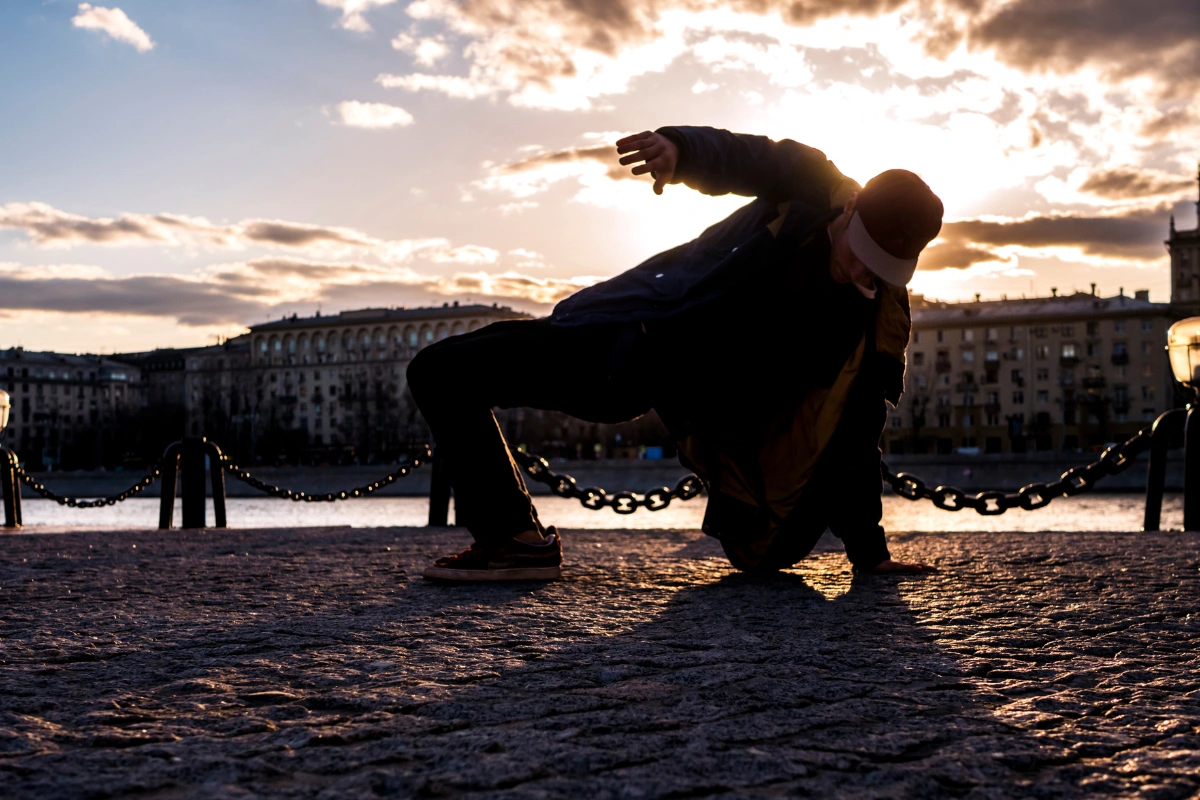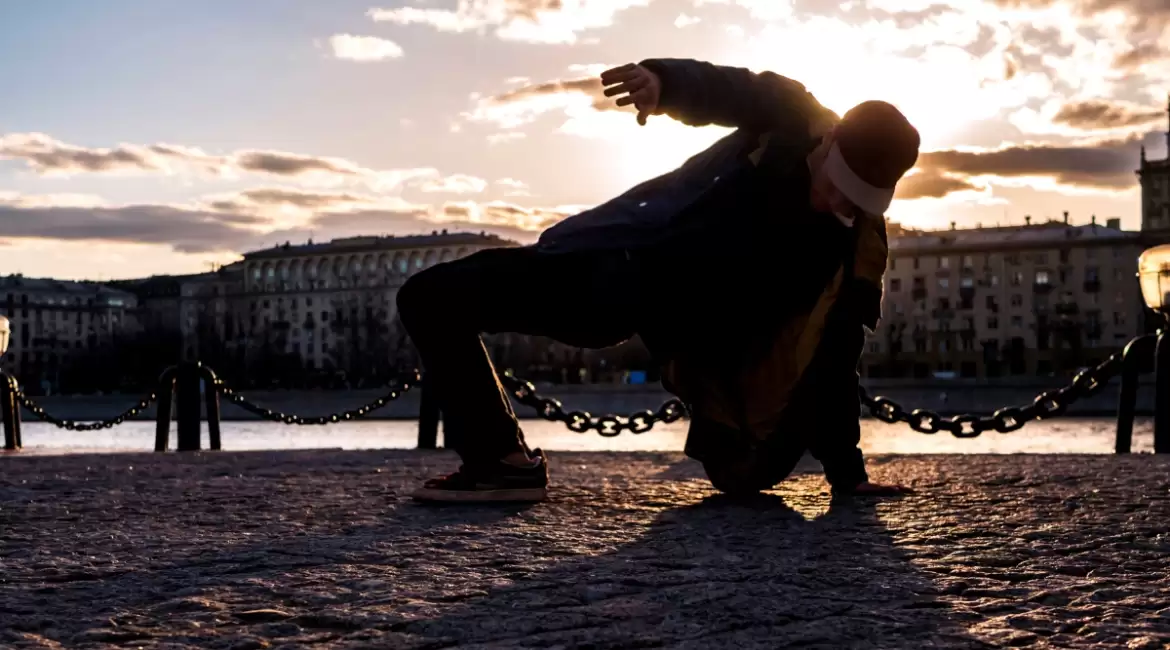Continuing our exploration of breakdancing freezes, Part 2 delves deeper into the diverse repertoire of poses that define this dynamic art form. From intricate variations like the elbow freeze and spider freeze to iconic moves such as the headstand and pike freeze, each freeze not only showcases technical mastery but also represents the creativity and innovation within breakdance culture. Join us as we uncover the nuances and significance of these freezes, highlighting their evolution and enduring impact on the vibrant world of hip-hop dance.
Bridge freeze
The bridge freeze, originally rooted in gymnastics, has been adapted and embraced within the breakdancing community as a signature pose. To execute this pose, dancers begin lying on their back. They then place one hand beside the right side of their head and the other hand beside the left side of their head on the ground. Simultaneously, their feet remain on the ground in a bent position, with knees facing the ceiling. Using the palms of their hands and the strength of their legs, they push their back and head upwards, creating a pronounced arch with their body. The highest point of this arch is typically the lower back.
Breakdancers often personalize the bridge freeze by incorporating stylistic variations. For instance, they may lift one leg off the ground or contort their legs into shapes like the figure-four position, enhancing the pose’s visual impact and demonstrating their flexibility and control.
This freeze exemplifies the fusion of athleticism and artistic expression within breakdancing, where traditional elements from other disciplines are transformed into dynamic and visually captivating moves. As breakdancers continue to innovate and push boundaries, the bridge freeze remains a testament to the versatility and creativity inherent in the evolving culture of breakdancing.

Airbaby
The airbaby is a highly challenging freeze that demands exceptional hand balancing skills, combining elements of strength, technique, and balance to achieve its visually striking position, often requiring years of practice to master.
Originating from breakdancing, the airbaby has also become a distinctive move in disciplines like calisthenics and specific styles of yoga. To perform the airbaby, both hands are firmly planted on the ground, with one elbow positioned on the lower part of the knee, providing a stable platform for the upper part of the elbow to support the knee. The other arm plays a crucial role in maintaining balance, adjusting and stabilizing the pose as needed.
This freeze exemplifies the fusion of athleticism and artistry, requiring precise control and coordination to sustain the position effectively. Its incorporation into different movement practices highlights its versatility and adaptability across various disciplines, showcasing the evolution and innovation within the realm of bodyweight exercises and physical expression.
As practitioners refine their technique and deepen their understanding of body mechanics, mastering the airbaby represents a significant achievement, demonstrating not only physical prowess but also a dedication to refining intricate details that define mastery in their chosen discipline.
Pike freeze
The pike freeze is a dynamic variation derived from the handstand in breakdancing, offering a distinctive twist that emphasizes agility and swift execution rather than sustained balance.
In the pike freeze, instead of supporting the body on both hands in a traditional handstand, the dancer elevates one hand off the floor while twisting their hips inward and drawing their knees towards the chest. This compact posture allows the dancer to use their free arm to grasp one or both feet, enhancing the pose’s aesthetic and technical complexity. Balancing on one arm becomes the focal point of this freeze, requiring precise control and coordination.
Typically, the pike freeze is executed swiftly, often lasting between 0.5 to 2 seconds, making it a dynamic element within breakdancing routines. This rapid execution adds a sense of fluidity and momentum to performances, showcasing the dancer’s agility and ability to transition seamlessly between movements.
For those preferring variations, the pike freeze can also be performed in an elbow-supported position known as the elbow pike, where the dancer leans on the forearm instead of the hand. This adaptation, known for its versatility and technical demand, underscores the evolution of foundational freezes within breakdancing, reflecting the ongoing innovation and creativity within the dance form.
Invert freeze
The invert freeze is a captivating variation of the handstand in breakdancing, characterized by a distinct positioning that adds flair and visual impact to performances.
To execute the invert freeze, the dancer begins by positioning their hands slightly wider than shoulder-width apart, with the hands turned inward toward each other. Unlike a traditional handstand where the body remains straight with the face looking towards the hands, the invert freeze involves tucking the chin towards the chest. This adjustment shifts the center of balance slightly backward, creating a deeper lean in the legs compared to a standard handstand.
In the invert freeze, the dancer further enhances the pose by drawing their knees towards the chest, creating a compact and inverted appearance where the face may be oriented towards the knees or feet. This distinctive orientation gives the impression that the body is upside down, lending a dynamic and visually striking element to breakdancing routines.
This freeze is renowned for its impressive aesthetics and technical challenge, requiring precise control over body positioning and balance. Its incorporation into breakdancing showcases the dancer’s agility and mastery of foundational techniques, while also highlighting the creative possibilities within the art form. As breakdancers continue to innovate and push boundaries, the invert freeze remains a hallmark move that embodies the athleticism and artistry of breakdancing culture.

Hollowback
The hollowback freeze represents one of the most challenging variations of the handstand in breakdancing, requiring exceptional skill and control to achieve. It builds upon the foundations of both the traditional handstand and the invert freeze, yet stands out for its distinct posture and difficulty level.
To execute the hollowback, the dancer begins with a standard handstand position but diverges by pushing their head forward through their arms while simultaneously leaning their upper body backward. This action creates a pronounced arch in the back, hence the name “hollowback,” with the legs extending closely above the ground. Unlike the invert freeze, where the focus is on tucking the knees towards the chest and facing them, in the hollowback, the dancer faces towards the ceiling with the legs extended in a low position.
Mastering the hollowback requires a delicate balance, as the challenge lies in finding the precise point where the legs hover as close to the floor as possible while maintaining stability and control. The pose’s aesthetic beauty is enhanced by its technical difficulty, requiring flexibility in the back and shoulders to achieve and sustain the desired form.
Additionally, practitioners can explore variations of the hollowback using a headstand instead of a handstand, known as the head hollowback, which further showcases the versatility and adaptability of this advanced freeze in breakdancing.
As dancers continue to push boundaries and innovate within the breakdancing community, the hollowback freeze remains a pinnacle of technical achievement, embodying the athleticism, creativity, and dedication inherent in mastering complex maneuvers within this dynamic art form.

L-kick
The L-kick freeze is a challenging and visually striking maneuver in breakdancing, requiring precise technique and balance to execute effectively.
To perform the L-kick freeze, the dancer initiates from a handstand position, entering similarly to how one would begin a cartwheel. Instead of stepping forward, the dancer places one straightened arm on the ground beside either the left or right foot, depending on personal preference. From this setup, the dancer lifts one leg into the air first, followed by the other, forming an L-shape with their legs.
Maintaining stability in the L-kick freeze is crucial, and dancers aim to hold the position for at least a second to emphasize its impact. Advanced practitioners may increase the difficulty by extending their free arm to touch the toe of one of their feet, adding a dynamic element to the freeze.
Mastering the L-kick freeze demands a combination of strength, flexibility, and precise body control. Achieving the L-shape with the legs while balancing on one arm requires rigorous practice and refinement of technique. This freeze not only showcases the dancer’s athleticism and agility but also demonstrates their ability to innovate and add personal flair to foundational moves in breakdancing.
As breakdancers continue to explore new variations and combinations, the L-kick freeze remains a hallmark of technical skill and creative expression within the vibrant culture of breakdancing, inspiring awe and admiration among audiences and peers alike.
Summary
Overview of Freezes in Breakdance (Part 2)” delves into a spectrum of dynamic poses that define breakdancing. From advanced freezes like the elbow freeze and spider freeze to iconic maneuvers such as the headstand and pike freeze, each pose exemplifies the athleticism and creativity inherent in breakdance culture. This exploration highlights the technical intricacies, artistic interpretations, and historical evolution of these freezes, illustrating their enduring influence on the ever-evolving landscape of hip-hop dance.


Leave a reply